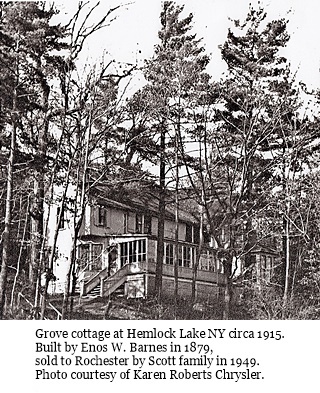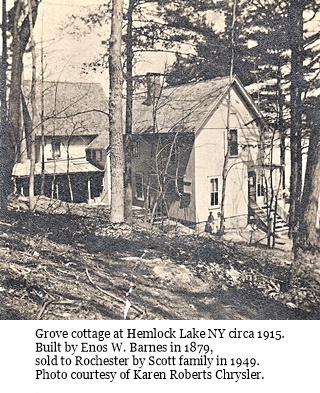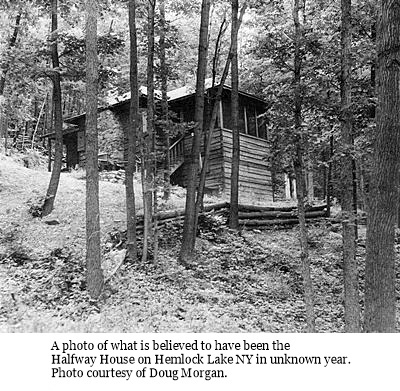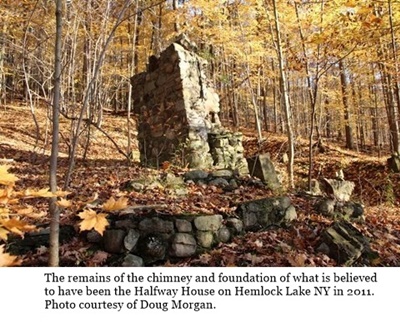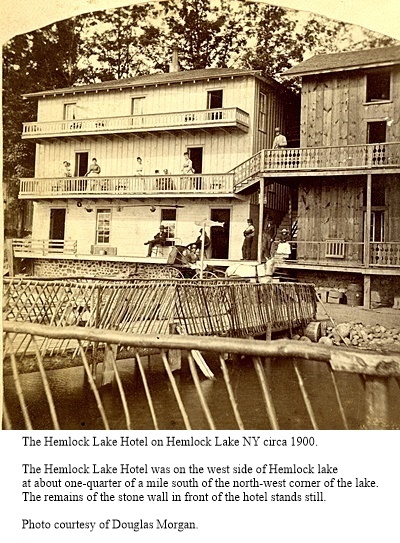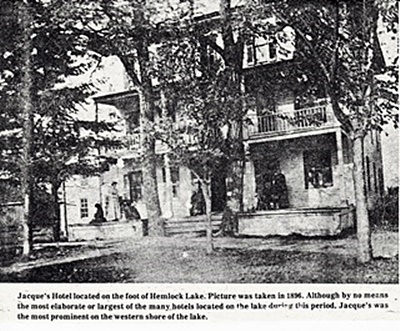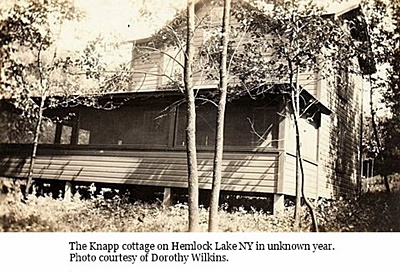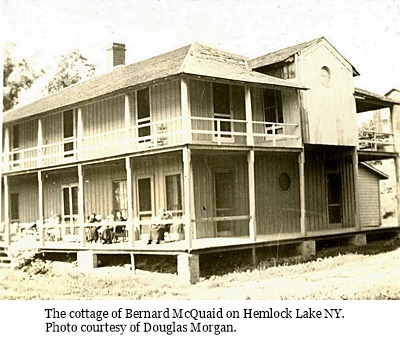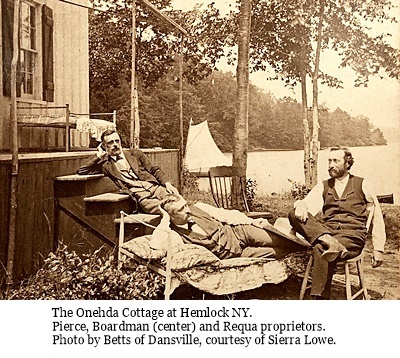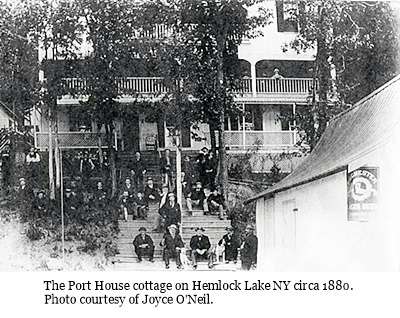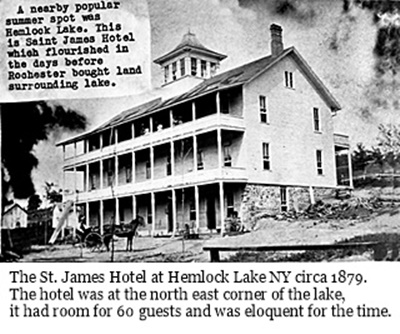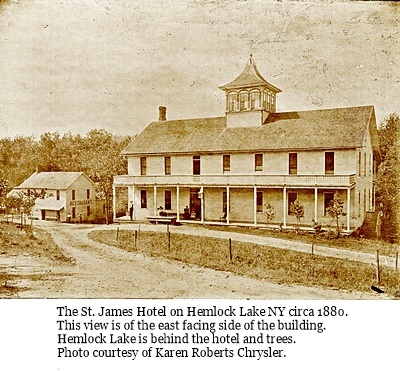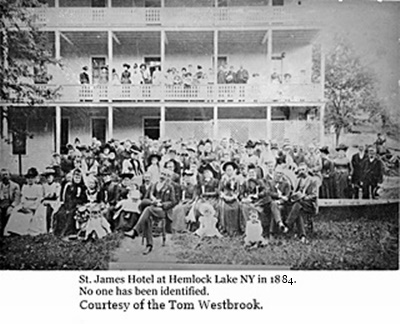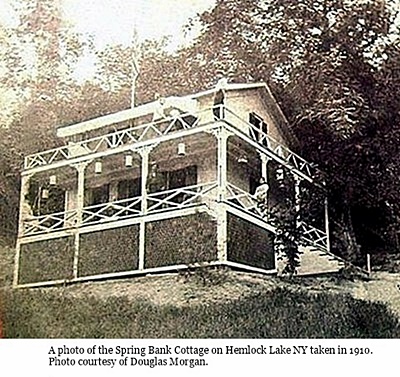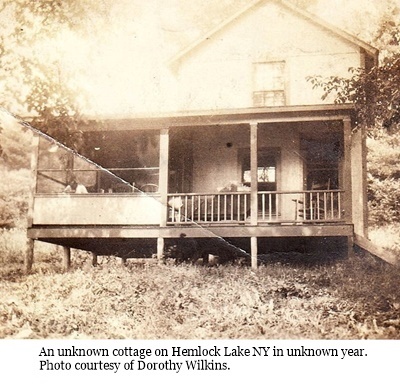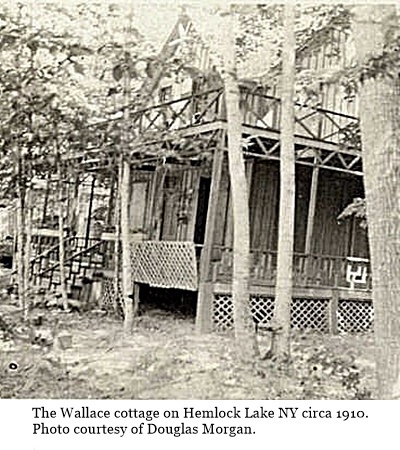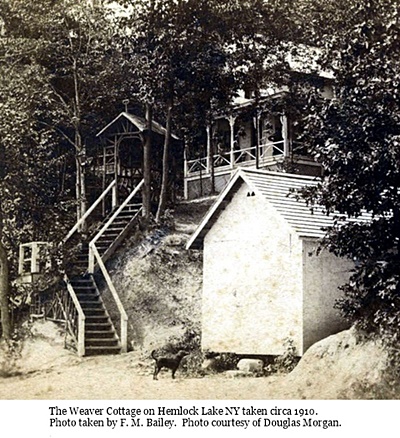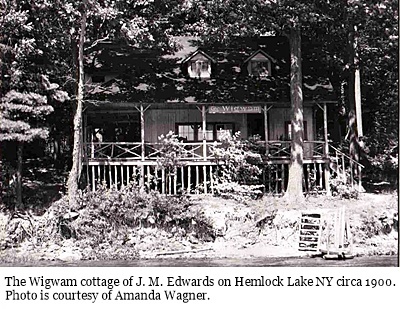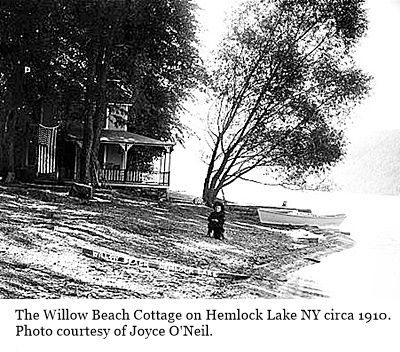
Welcome to Hemlock and Canadice Lakes!
Barns Businesses Cemeteries Churches Clinton & Sullivan Columns Communities Documents Events Time Line Fairs & Festivals Farm & Garden Hiking Homesteads Lake Cottages Lake Scenes Landscapes Library News Articles Old Maps Old Roads & Bridges Organizations People Photo Gallery Podcasts Railroad Reservoir Schools State Forest Veterans Videos
|
Cottages on Hemlock Lake |
Click any image to enlarge. |
|
1 |
There were over 200 cottages on Hemlock Lake before there was a single one on Conesus Lake. With the development of the lakeshore, Slab City became the village of Hemlock Lake, then briefly Holden, and finally simply Hemlock. Most of the hotels and cottages of Hemlock Lake were built in the latter half of the 19th century. The three story St. James Hotel opened in 1879 on the east shore of the lake. It was considered elegant for the time and had rooms for 60 guests. Other hotels on Hemlock included the Jacques House, the Port House, the Half Way House, and the Hermitage. The Lake Shore House was famous for its dance hall and fine restaurant. A cholera epidemic in 1852 was responsible for the growing city of Rochester to first recognize its need for a reliable water supply. After considering a number of alternatives, Hemlock Lake was chosen on the basis of its purity and elevation. The City of Rochester purchased the watershed and began removing the cottages. The cottages are alphabetically presented below with their map numbers. |
|
The Ashland Cottage (22) on Hemlock Lake NY. By D. B. Waite in 1883 Whether this cottage received its name because a few white ash trees stand around it, or from the old home of Henry Clay, we cannot tell. George and his better half put in some spare time each year.
|
|
The Atwell Cottage (6) on Hemlock Lake NY. By D. B. Waite in 1883 Before this lake became frequented, as now, with the busy throngs of pleasure-seekers, Geo. Atwell, of Lima, built a cottage on the west side of the foot, and each summer passed such time as leisure gave him, there. This was in 1870, and in the fall of ‘81 he sold to Kendall of the Jacques House, and built the cool, shady, gables we are now passing. A short distance south of here, you will perceive a small pile of stones below the road, and just north of the run. Here is where Joe Barnhart lived, long years ago.
|
|
The Atwell Cottage (39) on Hemlock Lake NY. By D. B. Waite in 1883 Geo. Atwell of Lima, who also had a cottage at the foot, built a 12 x 12 cottage here in 1878 solely for the purpose of sheltering him during his trout fishing excursions up the lake, for it is well known that trout are more plenty here than towards the foot.
|
|
2 Belle Cottage circa 1910, courtesy of Douglas Morgan. The Belle Cottage on Hemlock Lake NY. No history known for this cottage.
|
|
The Bennet Cottage (12) on Hemlock Lake NY. By D. B. Waite in 1883 The Hon. J. G. Bennett of Wayland, bought of Wm. Scidmore, in August, ‘73, and erected a portion of his present cottage in ‘74, on nearly the same spot where Martin Bowen, upwards of forty years ago, put up a frame for a house, and Guy Bennett in the latter year purchased of Wells, and moved his cottage thereto.
|
|
The Bethesda Cottage (31) on Hemlock Lake NY. By D. B. Waite in 1883 On the next point is a fountain, where the water is brought in a pipe from a spring on the side of the hill some twenty-five rods distant. It is very strongly impregnated with iron, and a careful analysis may disclose some chemicals held in a solution that may be of vast benefit to us ailing mortals.
|
|
The Blake Cottage (3) on Hemlock Lake NY. By D. B. Waite in 1883 The next one in order, is where B. J. Blake, of Livonia, spends many odd hours. It was built on the extreme north end of the Maloy point many years ago, and was taken over on the ice, in the winter of 1878 and ‘79.
|
|
The Blake Cottage (61) on Hemlock Lake NY. By D. B. Waite in 1883 Richard Blake of Livonia, in about ‘74, built the next, and Prof. Barnes of Rochester, in ‘80, the following cottage. Barnes has since sold his to Close and Reynolds, and their cottage bears the name Chestnut Grove.
|
|
The Bliss Cottage (67) on Hemlock Lake NY. By D. B. Waite in 1883 Seven years less than a century ago, Roswell Bliss, a descendant of Thomas Bliss who landed among the Plymouth Rockers in 1635, from cause or other, sought a home in the wilderness on the shores of this lake. He built a log house a short distance south of the present “Lima” house, now called Uncle Tom’s Cabin, and there his two children Charles and Eddy, were born, and Roswell died there in the spring of 1836. On the 21st page, we said that Phillip Short was the first settler to this lake; but since that was printed we learn that Roswell preceded him five years, and we here make the correction. This place was called “Blissport”, for a long time, in fact until the property changed hands. Our dates, though obtained through what we should consider a reliable standpoint, are nevertheless very conflicting. Some would have Charles Bliss born in 1814; the Lima house built in 1834 or 35, and sold in 1857. Wm. R. Bliss says, that his father was married in about 1820; Lima house was built in 1828, and sold in ‘47 or 48. The original purchasers of the building and grounds were, G. W. Atwell Sr., Levi Yorks, Harvey J. Wood and Albert Chapman, and they were bought for a Sportsman’s Club House. Mr. Wood afterward bought more land, and set out grape vines, fruit and ornamental trees. Atwell was the first to dispose of his interest, and Thomas P. Bishop was the purchaser, then Ambrose Hyde bought out Yorks. Josiah Leach put on the kitchen and thus obtained an interest; in the time Bishop bought out his partners and now remains the sole owner. Of the original owners, Atwell and Yorks are still living.
|
|
The Boone Cottage (29) on Hemlock Lake NY. By D. B. Waite in 1883 The year following, Henry W. Garnsey, then a hardware merchant at Wayland, put the main building on the next point. It was soon afterwards deeded to his wife and sister, Mrs. Stewart. In 1881 the addition was made, and in 1882, the property by purchase passed into the hands of Dr. Boone of Springwater.
|
|
The Borden Cottage (16) on Hemlock Lake NY. By D. B. Waite in 1883 A short distance up this point is where the “Stantonites” held a Camp Meeting which lasted some two weeks in the summer of 1878, and had an overflowing attendance especially on the Sabbath. Before we reach the next cottage we pass where Isaac B. Borden had a shanty, where he stayed while putting through the lake road in ‘26 and ‘27.
|
|
The Case and Smith Cottage (64) on Hemlock Lake NY. By D. B. Waite in 1883 Here Case and Smith in 1873, erected the south portion, and the increasing throngs of visitors demanding more room, the next season the north building was added, called when built, the Dancing Hall. There has been more business done here some seasons than at any other house on the lake. It is very well arranged and will accommodate a goodly number of boarders. From here towards the foot, we pass the cottages of Ex-Mayor Farland, built in ‘72; Kendall, in ‘71; Chambers and Martin; in ‘71; Case and Huntingdon, in ‘76, and Atwell (sold to Kendall in ‘81) built in ‘70. Then we come to greenwood Avenue, and a short distance in the background, the cottages of Ashley of the Clinton House, Rochester, and James Peck of Lima, similar in construction, erected in ‘80, Lake View, belonging to George Baker of Dansville, and the Johnson cottage, both erected in ‘81, and the long, and widely known home-lake farm house and most natural rural retreat upon the shores of this lake.
|
|
The Coggswell Cottage (41) on Hemlock Lake NY. By D. B. Waite in 1883 The fancifully-trimmed we are next to pass, belongs to William Coggswell, and took a place on this lake last year. If Hemlock will lower the temperature of summer heat, then his southern grove must give him ease and comfort. Before we arrive at the next cottage, we pass building sites, soon to be converted into pleasant resting places, and a patch of alders or gnarled oak, may suggest names for the new erections.
|
|
The Cooper and Snyder Cottage (18) on Hemlock Lake NY. By D. B. Waite in 1883 Next on the list is the cottage of H. R. Cooper, late of Washington but now of Springwater, and A. Snyder of the latter place. This was built in 1881. Though rather too near the water for pleasant surroundings to most people, yet the well kept grounds, the fine looking structure, and so well built and nicely arranged throughout, that it leaves a very good impression in the eye of the tourist.
|
|
The Curtice Cottage (23) on Hemlock Lake NY. By D. B. Waite in 1883 This is quite an extensive projection of land, and has long been known as “Curtice Point.” Perez H. Curtice a mill-wright by trade, but who loved fishing more than other employment, moved an unoccupied, small framed building from Hemlock Lake Village, on the ice in the winter of 1840-41 to this place. Here he lived alone, working occasionally a few days at a time at his trade, until 1849, when he went to William Mackie’s in Livonia to live. In the year 1864 during harvest time, he started at noon to go to Slab City and not returning, search was made but he was not found until in a fair state of decomposition, in the field near the west line of Jacques farm. His habitation on Curtice point was torn down and portions of it were afterwards used by boys as a raft.
|
|
The Day and Morey Cottage (5) on Hemlock Lake NY. By D. B. Waite in 1883 At the little ravine, stands the humble house of the Rev. S. M. Day and Morey of Honeoye. It dates its erection in the year 1880.
|
|
The Dorr Cottage (40) on Hemlock Lake NY. By D. B. Waite in 1883 The people of Dansville are of late choosing building places nearer the head than they did a few years ago. The next cottage, with its cool, spacious verandas, was erected last year by the Dorr brothers from the aforesaid place.
|
|
The Echo Rock Cottage (58) on Hemlock Lake NY. By D. B. Waite in 1883 L.A. Pratt, of Rochester, has settled a noble site, and erected an imposing home on the elevation of west Echo Rock. This was built in ‘81. Echo Rock is an ancient boulder, a waif from some old glacier, about which, many a fabulous story is told, famed in the legends of the Senecas. Many a war-hoop has here, no doubt, been sounded, and many an answer has been echoed back by a departed brother in the spirit land. Long years after their departure, a few lone Chieftains would annually resort to this scares relic, to renew sweet communication with the loved and lost; and ever when we have visited it, even in the stillness of twilight, we have fancied that “Lake and hill Are busy with their echoes still.”
|
|
The Edgewood Cottage (32) on Hemlock Lake NY. By D. B. Waite in 1883 Mrs. Thompson, wife of Furman Thompson of Springwater, is the proprietor of the next improvements. The cottage has received the name of Edgewood. This was built in 1879, and each season finds it pretty well appropriated to the uses intended.
|
|
The Englewood Cottage (8) on Hemlock Lake NY. By D. B. Waite in 1883 The Englewood cottage, was erected by the Millards of Hemlock Lake Village in 1878. ... From the Livonia Gazette, 23 August 1889 Miss Anna Riley, Mary Finnigan, Theresa Riley, Edna Trimmer, Lillie Hogan, Nellie Gilbert, Nellie Kresher and Stella Wilkinson are occupying the Englewood cottage at Hemlock Lake.
|
|
The Faulkners Cottage (44) on Hemlock Lake NY. By D. B. Waite in 1883 In ‘81 the Faulkners of Dansville, who annually seek the shores of some wildwood lake, or resort at the north, or the balmy air of Florida, put thought and some means into as pleasant and home-lake resort as any on the lake - in fact we can but call its style “symmetrical and intrinsically beautiful.” On the north edge of this point the Barnharts had a cabin, in which they lived while getting lumber for the Rochester Water Company in 1875.
|
|
The Forest Home Cottage (7) on Hemlock Lake NY. By D. B. Waite in 1883 On this point will be found three Cottages. The first was built in 1882 by John Littendorf, and he calls it Forest Home, and the name is very well applied.
|
|
3 Grove cottage on Hemlock Lake The Grove Cottage on Hemlock Lake NY. From the Avon Herald, 24 November 1949. The Scott family is going to give up its two tracts of land on the west shore of Hemlock lake for $39,000. Attorney George D. Newton of Geneseo represented the Scotts in a third condemnation proceeding begun a year ago by the City of Rochtester. “Theirs is about the last large parcel of land around the lake,” said Newton. It has been in the Scott’s possession for 75 years. The award was made to the Scotts by commissioners of appraisal appointed by a court. They awarded $23,000 to Mrs. Scott and her three children for 122 acres of sloping, partly wooded land with a frame cottage overlooking the lake and including also a garage, an ice house and a storage and guest building. The property has no lake frontage. They awarded to the son and the two daughters $16,000 for the second adjoining parcel, consisting of 1 1/3 acres of heavily wooded land with 170 feet of lake frontage and including a large 2 1/2-story house close to the shore. 4 Grove cottage on Hemlock Lake Deputy Corporation Council Frederick . Wilkens said the city has acquired either through condemnation or by purchase about 30 other parcels on both sides of Hemlock Lake in the program to enlarge the basin for the city’s water supply. The Scotts are Mrs. Gertrude B. Scott, and her three children, Rufus B. Scott, also of Wellsville, and Mrs. Gertrude E. MacDaniels and Mrs. Florence S. Roberts, both of Summit, N. J. The award of the court-appointed condemnation commissioners, Attorney Edward M. Ogden of Rochester, chairman, Ralph R. Borchard, Rochester real estate man, and E. Walter Moses, retired farmer of Dalton, is subject to confirmation by Supreme Court. Witnesses who testified on values for the claimant are W. B. Sanders of Nunda, Lockwood F. Youngs of Geneseo and Mrs. Anne Bigham of Canadaigua. Read about the Claude Scott Family here. |
|
The Grover Cottage (37) on Hemlock Lake NY. By D. B. Waite in 1883 We now cross the lake and commence our return, and in doing so we first pass near the place where young Willis was drowned in 1880, just south of the humble shelter where the late Dr. Norton from 1877 until his death, used to spend many a happy hour during the warmer portions of the year. His messmate, H. T. Grover, still continues to spend considerable time hereabouts, and is one of the few who follow the gentle art, that invariably have good luck. Harvey is endowed with a mighty taking way, especially when he goes a-fishing.
|
|
5 Halfway House circa 1940, courtesy of Douglas Morgan. The Halfway House (14) on Hemlock Lake NY. From the Livonia Gazette, 14 April 1876. Soon we arrive at the Half-Way house, a comfortable boarding place for visitors in a quiet way. The building stands on a rising hill slope, commanding a fine view of the lake and surroundings, has a good dock, complete fishing accommodations, a fine beach with croquet grounds, besides a never-failing sulphur spring quite noted for its healthful waters. Sojourners at this place find themselves rather crowed f over twenty call for accommodations, and still there is always room for one more, and he will go a long way before being better served, as this is quite a popular resort for all who love a good trout dinner, and here are the best trout grounds on the lake. Daily in Summer does the little steamer stop at the dock, and from her deck passengers long to get out and behold the beauties of nature from this old pioneer tavern of the ancient wilderness. Tradition has a history of this place, too long for a newspaper article, but old King’s flip, made with a quart of cider and sweetened with sugar and Croix rum - Good Lord, what did they do fifty years ago, and what jolly times these old stagers did have as they passed the stone pitcher round the social board. The strongest you get now is sulphur water. ...
By D. B. Waite in 1883 In opening the highway along the eastern shore of the lake in 1826, hands found it so inconvenient to climb the hill after a day at hard labor, that Abner Goodrich, erected a double log house below the road on this point, and moved thereto for his, and their accommodation. The next year when the road was completed, he built the old part for the present structure, and the balance was added by king in after years. In 1834 he sold to Porter Fowler, who leased it to Joseph King for eight years, then sold one half to John Martin, and the other half to John Jenkins who built a house on the hill. Philip Wetmore rented Martin’s half for two years. Five years from Fowler’s sale, the whole came back into his hands again. Samuel Darling was the next occupant, then Joseph King again. George and John King purchased it, and sold to H. J. Wemett, since that sale, Wemett, Yorks, Nivergall and Barnhart have occupied it. The log house in which Goodrich first lived, a son Charles, Patrick O’Neil and Martin Bowen afterwards occupied. This property passed from the hands of Wemett into those of George W. Fisher and Charles E. Upton, both of Rochester. Not having the same views in regard to what improvements to place thereon, and Upton’s late entanglement in Bank matters and failure to fulfill his part of the contract with Fisher, give to the place a truly desolate appearance, where the “thistle shakes its lonely head,” and the “wild fox digs his hole unscared.” The only cheering ray to be noticed here is a little to the southward, the fondly intertwining embrace of those two brotherly elms.
|
|
6 Halfway House in 2011, courtesy of Douglas Morgan. The Halfway House (14) Remains on Hemlock Lake NY. A Pleasant walk to the Halfway House at Hemlock Lake NY A short walk along the east shore of Hemlock Lake from the north boat launch will bring you to the remains of the Halfway House. After the end of the gravelled road, keep an eye up the slope to the east. The chimney has completely fallen over (2015) but can be found with a keen eye. After a close look at the chimney in both photos you will see the same pattern in the stone work.
|
|
The Hazel Dell Cottage (26) on Hemlock Lake NY. By D. B. Waite in 1883 The same year, on the extreme south end of Withington’s purchase, Geo. E. Withington now an Agent at Springwater Depot, and A. M. Brown of Rochester, completed the cottage in the cove above, and christened it Hazel Dell.
|
|
7 Hemlock Lake Hotel circa 1900, courtesy of Douglas Morgan. The Hemlock Lake Hotel on Hemlock Lake NY. The Hemlock Lake Hotel was on the west side of Hemlock lake at about one-quarter of a mile south of the north-west corner of the lake. The remains of the stone wall in front of the hotel stand still.
|
|
The Hendershot Cottage (17) on Hemlock Lake NY. By D. B. Waite in 1883 In 1878 John D. Hendershott of Springwater purchased the building in which Rufus Grover lived one season near the Reynolds farm by the butternut tree on the valley road, and moved it to the next place we come to. After covering it over anew and adding a kitchen, a very comfortable home for summer resort was made, and each season other families besides John’s occupy the cottage as renters.
|
|
The Hermitage Cottage (27) on Hemlock Lake NY. By D. B. Waite in 1883 The next one we hail seems to be an old veteran on these shores, which in fact it is. The first brush cut on this lake south of the Half Way House on the eastern shore, was where this cottage now stands. On Saturday May 29th, 1875, D. B. Waite took possession of this point and opened a road through as tangled a mass as ever grew, and on Monday the 31st, the sills were on the ground. The frame was raised the 11th, of June, and when fully enclosed, received the name of the Hermitage. The first landing built south of the center of the lake was built here July 26th, where the Seth Green landed a few days afterwards. All the business for the south end of the lake was done here for three consecutive seasons. Picnics have been of frequent occurrence here from the first to the present, in fact, were the only free picnic ground on the lake. The kitchen on the north was added in 1878. In 1848, Ebenizer Goodrich cleared this point for Perez H. Curtice who had a lease of it from Rufus Garey, and it was cultivated nine years. The timber has all grown since that time.
|
|
The Hoppough Cottages (59, 60) on Hemlock Lake NY. By D. B. Waite in 1883 H. P. Hoppough of Livonia, and Hoppough and Short, own the next two cottages. The former was placed here in 1879, the latter in 1880.
|
|
The Hunter Cottage (21) on Hemlock Lake NY. By D. B. Waite in 1883 The Rev., William Hunter, long a Presbyterian Clergyman of Springwater purchased the next point and erected the red building on the north end, and after cleaning off and improving considerably, sold the south end thereof to Geo. Higgins, of Springwater, and he in 1880 erected.
|
|
The Idle Hours Cottage (43) on Hemlock Lake NY. By D. B. Waite in 1883 During the last season, the Rev. G. K. Ward, of Dansville, Frank A. Ward, of Rochester, and Wm. S. Ward, of Leadville, Colorado, united, and the next summer home was the result. The sturdy elm on the south with one huge arm twisted off or that decaying parent oak in the cove below, leaning hopefully on its stronger brother, might have suggested a very appropriate name, but the one selected is very good.
|
|
The Idle Wood Cottage (48) on Hemlock Lake NY. By D. B. Waite in 1883 George W. Fisher of Rochester, in 1875 commenced to build here, and almost each year he added somewhat, either to his buildings or to the improvement of his grounds. The proprietor is decidedly a man of fine taste, and has shown in its numerous instances on his premises. It seems somebody was happy here in the year 1872, for on twin basswoods in the foreground you will find in large letters, “Camp Happy, 1872, Geneseo, N. Y.” As you pass southwardly on this point, you reach Glen Bridge, leading across a miniature run to the grove; to the west are Glen Hill, Glen Avenue, and other appropriate appellations as you ascend the zigzag walk up the hill.
|
|
The Ingleside Cottage (20) on Hemlock Lake NY. By D. B. Waite in 1883 Professor John J. Morris built the next in the season of 1881. The Prof. is here only during vacations, and for a bachelor, entertains a very social, agreeable family of young ladies and gentlemen of the literary class at such times, besides very many other acquaintances.
|
|
The Ingoldsby Cottage (68) on Hemlock Lake NY. By D. B. Waite in 1883 The last before we close our tour was built in 1880 by John Ingoldsby. This has since been sold, and is now under the care and supervision of the St. James.
|
|
The Jackson Cottage (66) on Hemlock Lake NY. No history known for this cottage. Read more about Jake Jackson here. |
|
8 Jacques Cottage in 1896, courtesy of Livonia Gazette. The Jacques Cottage (65) on Hemlock Lake NY. By D. B. Waite in 1883 In years long gone by, John Hannah was a humble dweller where now stands the Jacques House. When he sold in 1824 to Darius Jaques father to the present owner, little did he dream that the few fishermen that then occasionally called at his cabin, would ever make way for the numerous throngs of visitors that now pass the summer months at this pleasant, quiet home. Russel R. in 1851, built, for his own convenience, a comfortable farm-house, not expecting at that day, any visitors, save now and then, a fisherman; but in August, 1861, a Mr. and Mrs. Merryman and two children of New York City, but who came directly from the Dansville Water Cure, called to make it their home for a while. A short time afterwards, a Wheeler family, from the same place, took up a residence here until the next October. The year following, they came again, friends accompanied them, and from that time to the present, business has increased. In after years, this Mrs. Merryman became the wife of the noted Pere Hyacinthe. In 1872 or 3, he enlarged the building until the upright, 36x42, stands three stories in height and a two storied wing 80 feet in length, with very pleasant rooms; long, rambling piazzas, and cool, shady, cheerful surroundings. Seventy-five to one hundred visitors can be comfortably cared for at a time. After the house was enlarged, Alfred Kendall, a brother-in-law to Russel, had charge of it seven years, then E. R. Thompson, a son-in-law of Kendall, took the premises in charge, and it remained so for two years, when it again passed back into the hands of Jacques and Kendall. Those wishing to make much of a stay at this lake will find this as pleasant and as rural a home as any on its shores. Read more about the Jacques Cottage here. |
|
The Jenkins Cottage (38) on Hemlock Lake NY. By D. B. Waite in 1883 The building in the cove we next pass was built last fall by John Jenkins, in which to live while lumbering, and the next, is where Harvey Humphrey from Webster’s Crossing, in 1881 commenced to build, but left just enough relics to bring from the passer-by the thought, “who has been here?” Humphrey’s relics and the devastations of fire below leave a deadening feeling as we pass.
|
|
The Johnson Cottage (36) on Hemlock Lake NY. By D. B. Waite in 1883 This was erected in 1881, a little north and west of where Elijah Goodrich in 1828, put up a log cabin in which he resided many years, and after he left, it was occupied by Tucker, Gordon and others. At this point a landing was built of the Seth Green, in ‘75, but it was ephemeral in its existence.
|
|
9 Knapp Cottage in 19xx, courtesy of Dorothy Wilkins. The Knapp cottage on Hemlock Lake NY. No history known for this cottage.
|
|
The MacDonald Cottage (49) on Hemlock Lake NY. By D. B. Waite in 1883 Lawyer MacDonald, from Rochester, owns the next cottage. I was numbered with the west side improvements of this lake, in the season of 1882, and just below, we pass the cave banks, where John Martin Jr. was drowned, in 1842.
|
|
The Maloy Point Cottage (52) on Hemlock Lake NY. By D. B. Waite in 1883 This is by far the largest cape or point on this lake: “Outstretching far into the mere, An emerald set in crystal clear.” A cabin, in which hermit Maloy passed a few years, was built here in the year 1800, or one year later. Previous to the former date, he passed awhile on what is now called Cook’s Point, on Canandaigua lake; from thence he came to the Honeoye and settled beneath Maloy’s Bluff, and from thence to this place, as before stated. Daniels, Tittle, Farr, Jenkins and Mitchell have each made his home here; but as Samuel Tittle resided here longer than any of the others, it oftener receives his name than theirs. Ruel Blake was owner of the land for many years, and hence his name is often attached to it; but we see no good reason why it should not, by universal consent, have that old, veteran hunter Maloy’s name restored to it. A few years ago Bradner J. Blake had a summer cottage on the north end or prolongation of this point; but it was moved across the lake, and we have already noticed it.
|
|
10 McQuaid Cottage in 19xx, courtesy of Douglas Morgan. The McQuaid Cottage (51) on Hemlock Lake NY. By D. B. Waite in 1883 We next pass the boat house, from which starts the angling road up this miniature mountain, to the country home of Bishop McQuaid, and a little distance on, through the pleasing, cooling shade of pine and hemlock, northwardly, we find J. C. O’Brien’s. He is a Rochestarian, and much esteemed as the legal councillor for the Bishop.
|
|
The Miller Cottage (13) on Hemlock Lake NY. By D. B. Waite in 1883 Geo. A. Miller and Wm. Shannon of Springwater, bought a few acres, including the Sulphur Spring, in ‘78 and Shannon sold to Miller soon afterwards. In ‘81, Miller put up his summer house, and he has spent much of his time here, since then. Just south of his house is the Spring.
|
|
The Morehouse Cottage (15) on Hemlock Lake NY. By D. B. Waite in 1883 Here on Long Point George W. Morehouse, of Wayland purchased and built, especially for his invalid wife, the present tastily arranged cottage. She spent a portion of that season here, but that faul disease consumption had so strong a hold on her delicate constitution that death closed her earthly existence soon after her return to Wayland. The next winter Wesley Doughty now of Springwater became the purchaser, and one year after, his wife, in whose hands it now remains.
|
|
The Moss Rock Cottage (11) on Hemlock Lake NY. By D. B. Waite in 1883 This is the Tambling-Larrowe Cottage, erected in ‘79, by Tambling, and wife who was the widow Larrowe. They are residents of Liberty, and have one of the best made and most comfortable houses on the lake.
|
|
The Nivergall Cottage (62) on Hemlock Lake NY. By D. B. Waite in 1883 Fred Nivergall bought of Jaques in ‘68, quite a piece of land along the shore of the lake, and soon after put up the house in which he has since resided.
|
|
11 Onehda Cottage circa 1874, courtesy of Sierra Lowe. Shown are Pierce, Boardman (center) and Requa proprietors. The Onehda Cottage (45) on Hemlock Lake NY. By D. B. Waite in 1883 W. H. Pierce of Springwater, H. E. Boardman and Dr. Requa both of Rochester, in the year 1874, erected the first place for resort on this lake south of the “Maloy or Tittle Point.” As the building was constructed wholly of hemlock, the name Onehda, was decidedly a very appropriate one. In a state of nature, before fishing campers were plenty on the shores of this lake, one of the largest grape vines overran the timber on the outer projection of this point, and from that circumstance it received, and has long been called “Grape-vine Point.” Since Pierce became sole proprietor, he has taken off the timber and set the whole with fruit trees, and is beginning to enjoy the pleasure of having fresh-picked fruit for his otherwise well-furnished table.
|
|
The Picnic Point Cottages (55, 56, 57) on Hemlock Lake NY. By D. B. Waite in 1883 We find here a pleasant trio, belonging, in order, to Mrs. Ex-Senator Emerson, Martin and Cline, and C. Meyers, all of Rochester. The first was built in ‘79, the second in ‘77 and the last in 1880.
|
|
12 Port House Cottage circa 1880, courtesy of Joyce O’Neil. The Port House Cottage (35) on Hemlock Lake NY. From the Livonia Gazette, 26 June 1878. D. P. Alger has built the new Port House Hotel about half a mile from the southern extremity of Hemlock Lake, East side, and will open it for patrons about June 1st. The house is admirably located, being in a beautiful grove and having the most desirable surroundings. The steamer making regular trips will touch there, and a stage will run from Springwater Depot to the Hotel (three miles). The furniture and all appointments of the house will be new. ...
From the Livingston Republican, 9 October 1879 The Dansville Cornet Band had a picnic at the Port House, Hemlock Lake, September 30, and gave a dance in the evening which was well attended. ...
From the Dansville Advertiser, 17 June 1880 The third annual opening of the Port House, Hemlock Lake, will take place on Friday, June 18, when a free dance will be given during the afternoon and evening, Prof. C. C. Sedgwick of Dansville having charge of the music. The Port House is a nice place; Prf. Sedgwick will manage the dance in unsurpassed style; there will be other pleasures available, including fireworks in the evening; and an auspicious opening may be expected. ...
From the Dansville Advertiser, 16 September 1880 D. P. Alger, proprietor of the Port House, Hemlock Lake, has made arrangements for a day of pleasure at his hotel on Saturday, the 18th, in the shape of a free outdoor entertainment. Ira Allen will walk the rope and make an ascension with his monster air ship. The rope walking will take place at 2 o’clock p.m., and the balloon ascension between the hours of 3 and 5 p.m. The new and handsome steamer Mollie Tefft will be in readiness for lake excursions, a moonlight ride being one of the features of the evening. Music will be made by the Springwater Cornet band. Other amusements will be provided also. Those wishing to have a good time should make it a point to be present. ...
By D. B. Waite in 1883 D. P. Alger of Springwater, the next in order of location, erected the small building now attached to the north side of the main structure in 1876. In the fall of 1877, he commenced, and in the following spring finished the present boarding house, which soon after completion was named the Port House. It was first opened to the public on June 12th, 1878. The grounds on which it stands, though rather romantic, are not very pleasant or inviting for parties, picnics and gatherings that love to recline where “Some shady bower their couch could be, or rustling oak their canopy.” The buildings are well arranged for summer visitors, and though cheaply built like many of the cottages along the lake, yet they are commodious and comfortable enough for all who may wish to spend a few days or weeks here. The steam boats all run regularly to this place, and it is practically the head of the lake, though a short distance farther south stands the spacious farm house.
|
|
The Robinson Cottage (33) on Hemlock Lake NY. By D. B. Waite in 1883 Judge Stephen Robinson became the owner in the next, and put up the present building in 1877, and while his partner in life was able to enjoy a summer rest here, the aged, happy twain, accompanied by children and grandchildren spent many a pleasant day in and around their humble cot. Since her decease The Judge passed but a few days here each season.
|
|
The Rockaway Beach Cottage (50) on Hemlock Lake NY. By D. B. Waite in 1883 Here on the old “Tim Bailey Point” stand five summer rests. We will take them in order northwardly. Maple Hill, belonging to Mollie Tefft, of Rochester; Cedar Cottage, owned by George Reynolds, of the same place; Belle Haven, the property of A. C. Coleman, Washington D. C., all built in ‘79, and Glen Iris, belonging to Mrs. Robinson, of Rochester, and Sumac Lodge, owned by the Dyer brothers, of Dansville. These two were built in ‘78. When well populated, as these cottages are oft times, they form quite a lively, little hamlet. The Charter Oak in the foreground, reminds one but very little of the genuine, old oak at Hartford.
|
|
The Rudder Grange Cottage (28) on Hemlock Lake NY. By D. B. Waite in 1883 The sound of the ax had all but died away in a measure at the Hermitage when a peculiar looking craft was seen floating northward on the still bosom of the lake, and landed on Kellogg’s Point. The old boat house near the head had been demolished, and the debris soon assumed a cozy appearance, and after many remodelings took the name of Rudder Grange. This was in pioneer times and but a few days after Waite commenced on his grounds. No one on the lake has enjoyed himself better, wearing away the rough points in nature than has Nathan A. Kellogg, and his present and commodious and tasty cottage erected in 1880, bespeaks a man that aims to enjoy all this silvery gem of water has in store for him.
|
|
13 Saunders Cottage circa 1895, courtesy of Sierra Lowe. The Saunders Cottage on Hemlock Lake NY. Built for Addie Saunders by her sons Dick and Darwin.
|
|
The Sheep Pen Point Cottage (19) on Hemlock Lake NY. By D. B. Waite in 1883 This point, which is a pretty one, derives its name from the fact that for a very long period of years the farmers of Ball Hill had a pen here, and where they annually came to wash their sheep. It is now owned by the brothers, Robert H., an Attorney at Law, and Major Henry A. Wiley, both of Springwater. When N. A. Kellogg erected his present cottage he disposed of his former one to these brothers, and in the winter of 1881-82 it was taken here on the ice. They have otherwise built and have now a cozy summer home. These bachelor brothers spend hours very pleasantly here when other duties will permit them so to do.
|
|
14 St. James Hotel circa 1879, courtesy of Tom Westbrook. The St. James Hotel (1) on Hemlock Lake NY. By D. B. Waite in 1883 Before we take our departure, we will say, that this well built and commodious Hotel stands forty by eighty feet on the ground, three stories in height, is well finished and furnished throughout, for one located on an inland resort like this, was built in the season of 1879, by Daniel S. Beam, for Whitney and Ackley, and was opened to the public in the summer of that year. Whitney and Ackley have been its constant proprietors, and the business it has done must be its best recommendations. It is capable of accommodating sixty regular boarders besides transient ones. Here will be found free picnic tables and seats; accommodating employees, and decidedly the best arranged public grounds on the lake. In the cove on the north of the landing, is where young Shepard was drowned. |
|
15 St. James Hotel circa 1880, courtesy of Karen Roberts Chrysler. The St. James Hotel (1) on Hemlock Lake NY. From the Livonia Gazette, 6 August 1884. Hemlock - In the early spring we published an article relating to and describing the new hotel projected by Messrs. Whitney & Ackley on the east side of Hemlock Lake. At that time the building which was to be used as a billiard parlor, with a second story as a dancing hall, and also the barns, were erected, only the ground being broken for the hotel proper. This it will be remembered is several rods from the other building, and is three stories high, with the basement. The dining and sitting rooms are on the lower floor, where also is a separate dinning room for private parties. The office is on the second floor. The sleeping rooms are large and so arranged as to secure the most fresh air. One of the best features of the hotel - a feature that most hotel proprietors seem to forget in building - are the two large verandas on both the east and west sides, so it is the fault of the guest himself if he allows the hot rays of the sun to get at him at all. In addition to this, a large cupola has been erected on the top, so that a view of almost the entire length of the lake can be had. The inside of the hotel will be finished in hard woods. A large ladies’ sitting room faces the lake, protected by the shade, though the beautiful view remains unobstructed. One of the nicest groves on the lake is found here, which the proprietors offer free of charge to Sunday-school and other picnic parties. This is a gradual slope to the lake and is furnished with tables, rustic benches, etc., for their use. The home dock of the steamer Corabelle is at this house, which makes regular trips, and can be chartered for parties of all kinds at reasonable rates. A free stage to and from the trains will also be run by Hawley Bishop for the benefit of regular guests of the house. The terms of the hotel are as follows: Board by the week, from seven to ten dollars; by the day, two dollars; children under twelve years of age and servants, half price. Satisfactory terms will be made for families desiring to remain several weeks. This hotel has been built at a large expense, and no pains have been spared in suitably furnishing it. It will be conducted as a first-class hotel should be, and we believe the proprietors will find that their money has been well invested. The fame of Hemlock as a summer resort is increasing so rapidly that the accommodations are becoming inadequate to the demand upon them, though the lake boasts of good hotels and is dotted thickly with cottages; and the building of the St. James is still another invitation for tourists to come and enjoy the beautiful scenery the lake affords. No time has yet been decided upon for the formal opening, but due notice will be given.
|
|
16 Group at the St. James Hotel in 1884, courtesy of Tom Westbrook. The St. James Hotel (1) Accommodates Camp Meeting From the Livonia Gazette, 8 August 1884. Hemlock - The grounds of the St. James last Sunday were crowded with carriages, and hundreds took the boat at the dock, leaving their horses at the hotel barns. This was the handiest way to attend the camp-meeting. The St. James does its share of the hotel business on the lake, and a pleasanter location, or a more convenient spot for picnics and excursions, cannot be found anywhere. Whitney & Ackley give the free use of their grounds and tables to Sunday schools and other societies, a fact which ought to be and probably is appreciated.
|
|
17 Spring Bank Cottage in 1910, courtesy of Douglas Morgan. The Spring Bank Cottage on Hemlock Lake NY. From the Dansville Advertiser, 10 July 1879. Mrs. Robinson has changed the name of her cottage from Glen Iris to Spring Bank. A new piazza has been built. It commands a lovely view of the lake-side. The grounds in front are put in good shape.
|
|
The Sunnyside Cottage (25) on Hemlock Lake NY. By D. B. Waite in 1883 Withington sold a portion of his purchase in 1878, to Grover and Morris of the same place, and they, fore seeing the future of this body of water, put up in the same season what was then considered an extreme in summer resorts, by far the best building in its vicinity. Its name is suggested by the unobstructed view from its sunny side, or from, perchance, Irving’s pleasant home on the Hudson.
|
|
The Swarts Cottage (34) on Hemlock Lake NY. By D. B. Waite in 1883 John Swarts, of Dansville, purchased of Judge Robinson in ‘79, a portion from the south end of his premises and placed a cottage thereon the same year.
|
|
The Tanglewood Cottage (47) on Hemlock Lake NY. From the Dansville Advertizer, 10 July 1879 The Ward-Stearns-Fielder cottage now bears the name of Tanglewood on its front, the Parsonage being finally discarded. A large flag hangs on the piazza which is soon to float from a tall liberty pole. ...
By D. B. Waite in 1883 This is the original Parsonage, and was built by G. K. Ward, J. J. Bailey, F. Fielder, M. A. Sterns, J. P. McCurdy, E. M. Parmelee, H. F. Dyer, J. M. Edwards, J. F. Williams, H. J. Faulkner, S. N. Hedges, H. W. Delong and G. Sweet, in 1877. In ‘79, Ward, Fielder and Sterns bo’t out their partners; in ‘81, Ward sold to his partners, and Fielder, in ‘82, disposed of his interest to Sterns, who is sole owner at present. A little in the back-ground, “Crazy” Walker commenced to build a home, away from the busy scenes of civilization, in 1862; the cellar remained till lately disturbed, though somewhat dilapidated.
|
|
The Thurston Cottage (4) on Hemlock Lake NY. By D. B. Waite in 1883 Last season George Thurston, also of Livonia, built the rather tasty cottage, on nearly the identical ground where McCloud lived, “in the days of old lang syne.” He is an old camper on this lake, and before we end our tour, we shall pass his trail for the third time.
|
|
The Todd Cottage (30) on Hemlock Lake NY. By D. B. Waite in 1883 In 1878, Mrs. Garnsey and Mrs. Stewart sold that portion of their land on the south end and lying in the cove to Todd of Spencerport, and he soon after erected the present small but agreeably arranged cottage.
|
|
The Twin Cottages of Karl and Dewey (53, 54) on Hemlock Lake NY. By D. B. Waite in 1883 The twins belong to Tom Karl, the celebrated musician, and D. M. Dewey Jr. or Rochester. They were erected in ‘79, and they indicate unity and brotherly love. ...
The Obituary of Thom Karl. From the Livonia Gazette, 24 March 1916 The death of Tom Karl in Rochester the other day takes some of us old residents of Hemlock back to the days when the Karl and Dewey cottage was the show place at the lake. Tom Karl was always popular with the cottagers and visitors to the lake. He made plenty of money, and he always seemed ready enough to part with it when here, if doing so would give any enjoyment to himself or his friends. The Karl and Dewey cottage was filled summers with distinguished musical people, and many are the moonlight nights that the writer of these lines has sat in his rowboat, all alone, and listened in the moonlight to Barnabee and McDonald and Karl and Marie Stone and others, as their voices from the cottage came over the quiet waters of our beautiful Hemlock lake. Some of the friends of Tom Karl are still here. Those were great days for Hemlock lake, but they will never be repeated.
|
|
The Union Cottage (9) on Hemlock Lake NY. By D. B. Waite in 1883 During the season of 1879, John Morley from Lima commenced a series of improvements, which have culminated in one of the most lovely and delightful places of resort on this lake. John knows how to make the wilderness blossom, and out of a tangled wood, he has made a pleasant retreat. South of this a short distance, Hiram Bowen and Tom Saxby, in about 1840, had log cabins; Bowen’s at the pile of stones above the road, and Saxby’s, where the portable Steam saw mill was. Tom was a thorough-bred boxer.
|
|
18 Unknown Cottage in 19xx, courtesy of Dorothy Wilkins. Unknown Cottage on Hemlock Lake NY. No history known for this cottage.
|
|
19 Wallace Cottage circa 1910, courtesy of Douglas Morgan. The Wallace Cottage on Hemlock Lake NY. No history known for this cottage.
|
|
The Ward Cottage (42) on Hemlock Lake NY. By D. B. Waite in 1883 It is extremely rare that we find so devoted a lover of nature as the Rev. George K. Ward of Dansville. For the last eighteen years, he has been a frequenter in these parts, and was one of the original proprietors of the old parsonage, and a partner in the cottage, erected by the Wards last season, and now is busily engaged in the erection of this one, which will be completed early in the season. At his touch the wilderness is quickly converted into a pleasing home.
|
|
20 Weaver Cottage circa 1910, courtesy of Lore Disalvo. The Weaver Cottage (63) on Hemlock Lake NY. By D. B. Waite in 1883 C. S. Weaver of Rochester, in ‘79, and Editor Barnes of the Steuben Courier, in ‘77, built on different sides of the gully, and Prof. Cook of New York, in ‘79, a little lower down on the lake; Mrs. Dixon of N. J., the hexagon in ‘73, and Mrs. Parmalee of Livonia, the Wren’s Nest in ‘79.
|
|
The Wemett Cottage (2) on Hemlock Lake NY. By D. B. Waite in 1883 Before you fairly get under way, you pass the summer residence of H. J. Wemett, the owner and manager of the steamer “Corabelle.” He built here in 1881, and the head-quarters of his boat are here, or at the dock of the St. James.
|
|
21 Wigwam Cottage circa 1900, courtesy of Amanda Wagner. The Wigwam Cottage (46) on Hemlock Lake NY. By D. B. Waite in 1883 J. M. Edwards of Dansville, in 1879, chose his wigwam on the next building place. On the south lies “Sassafras Bay,” and from a huge cement tube on the shore of said bay, you can regale your olfactories, if you desire thusly to do, and enjoy his cooling, hemlock shade. We pass a fine building spot, and, northward “in sequestered cove, the wild duck’s oiled his breast, and dove.”
|
|
The Wildwood Cottage (10) on Hemlock Lake NY. By D. B. Waite in 1883 H. S. Rosenkrans of Wayland, in ‘78, selected a shady grove, and has a comfortable cottage and stables, where he enjoys himself, during the sultry days of summer, when other duties will permit. ...
From the Naples Record, 22 August 1888 Mrs. George Case, with her guests, Mrs. Hallenbeck, of Rochester, and the Misses Maggie and Minnie Baldwin, of Howard, leave Thursday for a week’s stay at “Wildwood Cottage,” Hemlock Lake.
|
|
22 Willow Beach Cottage in 1910, courtesy of Joyce O’Neil. The Willow Beach Cottage on Hemlock Lake NY. No history known for this cottage.
|
|
23 Willow Beach Cottage in 1910, courtesy of Joyce O’Neil. The Willow Beach Cottage on Hemlock Lake NY. No history known for this cottage.
|
|
24 Willow Beach Cottage in 1910, courtesy of Douglas Morgan. The Willow Beach Cottage on Hemlock Lake NY. No history known for this cottage.
|
|
The Withington Cottage (24) on Hemlock Lake NY. By D. B. Waite in 1883 On this point Albert M. Withington, then Depot agent at Springwater, bought and built the north structure, a very much better one than any cottage away from the foot of the lake at that time. This was in the summer of 1876, and at the time when the excitement had fairly commenced at the south end of the lake.
|
|
25 Woodruff Cottage in 19xx, courtesy of Dorothy Wilkins. The Woodruff Cottage on Hemlock Lake NY. No history known for this cottage.
|


